Early voting for the starts on Tuesday and millions of Australians will be asked to cast their vote over the next two weeks.
Voting is something that almost every adult is required to do and it will influence how the country is run for the next three years.
Counting of ballots will commence once the polling booths close at 6pm on — 3 May — and could have an impact on the cost of living, climate change, defence, foreign policy, and health and education services.
The decision on who to vote for can feel daunting, especially if you are unfamiliar with how preferential voting works.
Here's how you can make sure your vote counts.
Who are you voting for?
In 2025, voters will help elect 150 members of parliament (MPs) in the House of Representatives — also known as the lower house — and 40 out of 76 senators in the upper house.
You will be asked to fill out two ballot papers. A small green one for the House of Representatives and a larger white paper for the Senate.
Voters have to individually rank candidates on their ballot paper for both houses of parliament.
On the green paper, citizens must rank every candidate to determine who will represent their local electorate. On the white paper, you only need to rank either six parties or 12 candidates.

A House of Representatives ballot paper from a 2015 by-election in Western Australia. Source: AAP / Richard Wainwright
Because candidates are ranked in order of preference, a person's vote can be counted multiple times as part of this process.
This differs from places like the United States, the United Kingdom or India, where candidates win based on the majority from a single count, a process known as first-past-the-post.
'Knockout' rounds: How your preferential vote works
When voting closes, Australian Electoral Commission (AEC) officers will immediately lay all ballot papers out on the table and sort them by the number of "1" votes each candidate has received.
If one candidate receives at least half the votes, then they will be elected.
If a majority is not reached, the AEC starts to exclude candidates with the least amount of votes.
AEC spokesperson Pat Callanan explains as candidates are "knocked out", the vote is transferred to the candidate ranked as the next preference on the ballot.
"If your first candidate [the one you mark as '1'] is knocked out, your ballot paper will be transferred to your second, third, fourth, fifth preference," he told SBS News.
"[This continues] until there are only two candidates left, and your vote is sitting with one of those final candidates."

Eligible voters can cast their ballots on election day or at certain early polling stations.
The white ticket or Senate ballot is a little more complicated — it goes through both human and computer checks to determine who is elected using a specific formula to calculate a quota.
The voter has two choices when it comes to the Senate. You can vote 'above the line' on the ballot paper by ranking at least six parties, or 'below the line' by ranking a minimum of 12 individual candidates.
The image below shows a ballot paper where the person has chosen to vote above the line.

This mock Senate ballot shows how to vote above the line. Source: Supplied / AEC

This mock Senate ballot shows how to vote below the line. Source: Supplied / AEC
He said it is important to follow the instructions and mark enough boxes, or risk your vote not being counted.
In the House of Representatives, this means marking all boxes.
But in the Senate, because you are not required to number every box, your preferences can exhaust before counting reaches the final two candidates — especially if you are not voting for the major parties — meaning your ballot will be set aside for the remainder of the count.
The AEC explains that for some people, allowing their Senate ballot to exhaust rather than have their preferences flow to somebody they don't like is a valid way of voting.
What about preference deals?
You may have heard of preference deals — where a political party agrees to give another party its vote if they are knocked out of contention during the counting process.
Callanan said this is a "historical hangover" and these deals are not as powerful as they once were.
Until 2016, voters could mark only one number next to a party in the Senate. This allowed the party to decide where votes would go, according to preference deals they made with other parties.
However, parliament passed reforms and changed the voting system, effectively ensuring that "preferences are fully in the hands of the voter", according to Callanan.
Parties can now only offer suggestions on their how to vote cards, which recommend how they would like voters to rank candidates. These cards are handed out at polling booths by volunteers from different political parties.
"It's up to the voter if you want to follow that or not."
Visit the to access articles, podcasts and videos from SBS News, NITV and our teams covering more than 60 languages.




